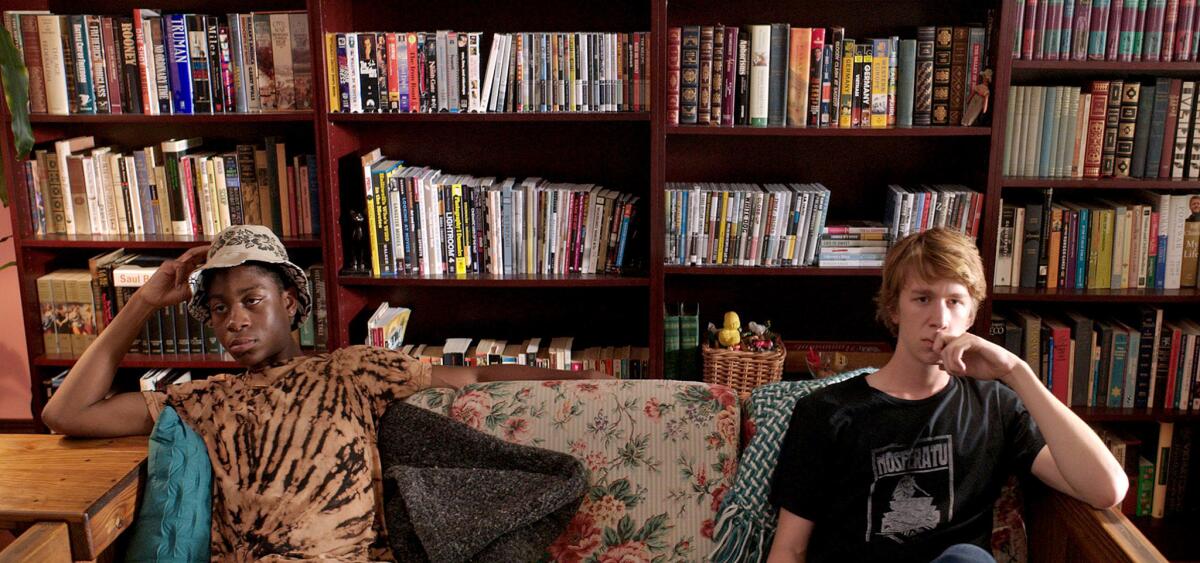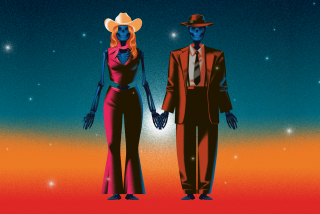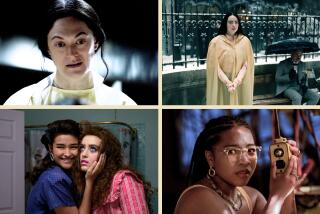Sundance 2015: ‘Me and Earl and the Dying Girl’ as fest breakout

It has a name a little like “Lars & the Real Girl” and it plays like the baby of “The Fault in Our Stars” and “Juno” (though not the baby from “Juno” that ends up with Jennifer Garner).
Yet for all its clear influences, all its cinematic signposts (when Nick Offerman shows up as a clueless dad, you know you’re in an indie dramedy), all its tricks and flourishes and Sundanciness, “Me and Earl and the Dying Girl” is the breakout of the festival. It is the movie hailed as different than all the others here, the original piece by which its host festival and maybe a lot more will be measured.
By now you may know the plot for the Alfonso Gomez-Rejon film, which has been acquired by Fox Searchlight in a big deal that will mean a big release. Or you may not and just assume it.
Quickly: A likable but detached high school senior named Greg Gaines (Thomas Mann) learns that a classmate is about to undergo chemotherapy for recently diagnosed leukemia. Reluctantly, at the prodding of his mother, he visits the girl, a sweet but non-descript child of a single mother named Rachel (Olivia Cooke).
Soon an enjoyable but complicated friendship develops; even as she’s getting sicker, Greg remains in denial. (There is less of a focus on the strictly medical side of things in “Fault,” in part because it’s Greg’s story far more than Rachel’s.)
Meanwhile, Greg enjoys a close, long-term friendship with Earl, a black teen we’re told is from a tough neighborhood. Earl is the candor-loving foil to Greg’s wishy-washiness. It’s that friendship, along with Greg’s relationship with Rachel, that informs his character more than the other way around. Ultimately it’s about how Greg tries to overcome his (not-entirely-convincing) self-loathing ways. “Dying Girl” is a three-hander that’s really a one-hander.
The film is unashamedly sentimental as it focuses on death and loss, but it trades in that sentiment with grace. When Jesse Andrews’ script gets to the section he clearly marked “Waterworks,” it earns the tears. You reach for the Kleenex for a reason, or several reasons, not least that he didn’t try to have you reach for them before. If you’re not crying, all those things your ex said about your emotional wall may be true after all.
At a question-and-answer session after the screening, Gomez-Rejon cited movies like “Harold and Maude” as inspiration. “It’s that school of filmmaking — nothing too slick,” he said. “One false note and it becomes sentimental … becomes inauthentic.”
The script is witty and layered with savvy references — there’s a Pussy Riot joke in the first minute — and is also deeply cinephilic. There are riffs on movies — complete standalone set pieces, constructed by an outside team — centering on fake movies that Greg and Earl come up with as parodies of real classics like “Blue Velvet” and “Apocalypse Now.” They’re fun bits that nonetheless exist only in Sundance movies. (If an alien landed on this planet and tried to understand modern youth by the films here, he’d think all American kids did was sit around and pay homage to 20th-century cinema greats.)
As Mann, best known for the teenage rager “Project X,” said after a screening here, “I’ll never find another script that lets me have a Werner Herzog monologue.” (He actually has more than one.)
“Dying Girl” has the kind of arty stylings that puts it into a particular subgenre. There is animation and voice-over and on-screen chapter headings with phrases like “The Part Where” and many other arch touches. At one point, the camera flips on its side so that we’re watching the action at a 90-degree angle. If the movie wasn’t here, Fox Searchlight — of “Napoleon Dynamite” and “(500) Days of Summer” Sundance fermentation — would have to invent it. But the film does all of this against a very morbid backdrop. And therein lies the novelty. Death may be near, but quirkiness abides.
The film’s back story is a good one — Andrews, also the source novelist, had never previously read a script, let alone written one. Gomez-Rejon, known for episodes of “American Horror Story,” had come back to Sundance after he worked on a festival movie called “In the Soup” ... in 1991. And the film stars Thomas Mann, a 23-year-old who, as he noted, has been “playing 17 for the last six years.”
The response has been ecstatic. This may be one of those times a statement like that is actually an understatement. The Hollywood Reporter began its review by calling “Dying Girl” a “home run” and a “smart.. charmer, merciless tearjerker and sincere celebration of teenage creativity.” A Variety review said the film “is destined not only to connect with young audiences in a big way, but also to endure as a touchstone for its generation.” That’s a lot to put on any movie, no matter how well done.
I suspect that, though the backlash hasn’t hit yet, it will, especially, fairly or not, for a festival whose big breakout last year was the far more epic and serious “Boyhood.” There will be other discussions too — about a key piece of narrative misdirection, about how it handles race with the Earl character, and how it deals with illness. “Dying Girl” will be embraced by those who like the answers to those questions and derided by those who don’t. It’s hard to say which way all of this will go, culturally. But the conversation itself is inevitable. That’s what happens when you’re a Sundance breakout.
More to Read
Only good movies
Get the Indie Focus newsletter, Mark Olsen's weekly guide to the world of cinema.
You may occasionally receive promotional content from the Los Angeles Times.







